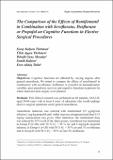Please use this identifier to cite or link to this item:
http://hdl.handle.net/11547/10163| Title: | The Comparison of the Effects of Remifentanil in Combination with Sevoflurane, Desflurane or Propofol on Cognitive Functions in Elective Surgical Procedures |
| Authors: | Kalyon Türkmen, Seray |
| Issue Date: | 2016 |
| Publisher: | ISTANBUL AYDIN UNIVERSITY INSTITUTE OF SOCIAL SCIENCES |
| Abstract: | Objectives: Cognitive functions are affected by varying degrees after general anaesthesia. We aimed to compare the effects of remifentanil in combination with sevoflurane, desflurane or propofol on haemodynamic variables, post anaesthesia recovery and cognitive functions in patients for whom head and neck surgery were planned. Methods: This clinical research was performed on 60 patients, ASA I-II, aged 20-60 years with at least 8 years of education who would undergo elective surgical operations under general anaesthesia. Anaesthesia induction was realized with remifentanil 0.5 µg/kg/min infusion,1 mg/kg propofol until verbal response disappeared and then 0.15 mg/kg cisatracurium was given. After intubation, the remifentanil dose was reduced by 50 % in all of the three groups. Anesthesia was maintained in Group P (n=20) with 50 % O2 + 50 % air and 6 mg/kg/hr propofol infusion, in Group S (n=20) with 50 % O2 + 50 % air and 1% sevoflurane and in Group D with 50 % O2 + 50 % air and 3% desflurane. 1 Department of Anaesthesiology and Reanimation, Okmeydanı Teaching and Research Hospital 2 Department of Internal Medicine, Okmeydanı Teaching and Research Hospital Özgün Araştırmalar (Original Research) The Comparison of the Effects of Remifentanil in Combination with Sevoflurane, Desflurane or Propofol on Cognitive Functions in Elective Surgical Procedures 18 Mean arterial pressure and heart rate were recorded before induction, after induction, 15 minutes after intubation and at every 30 minutes after operation. At the end of the operation spontaneous eye opening time and time for Aldrete score ≥ 9, as well as postoperative side effects and cognitive functions were evaluated. Trieger Dot Test and Digit Substitution Test were performed on the day before surgery and at 15th, 60th and 120th minutes after the surgery. Results:The demographic data and duration of surgery were similar in all the groups. A statistically significant difference was determined in mean arterial pressure at the first minute after induction between Group P and Group D (p<0.05). Aldrete recovery scores were completed in all groups at the 15th minutes (>9). There were no difference between groups in terms of side effects, DSST and TDT scores. Conclusion: We concluded that all three methods may be used as alternatives to each other with similar satisfactory results. |
| URI: | http://hdl.handle.net/11547/10163 |
| Appears in Collections: | Untitled |
Items in DSpace are protected by copyright, with all rights reserved, unless otherwise indicated.

